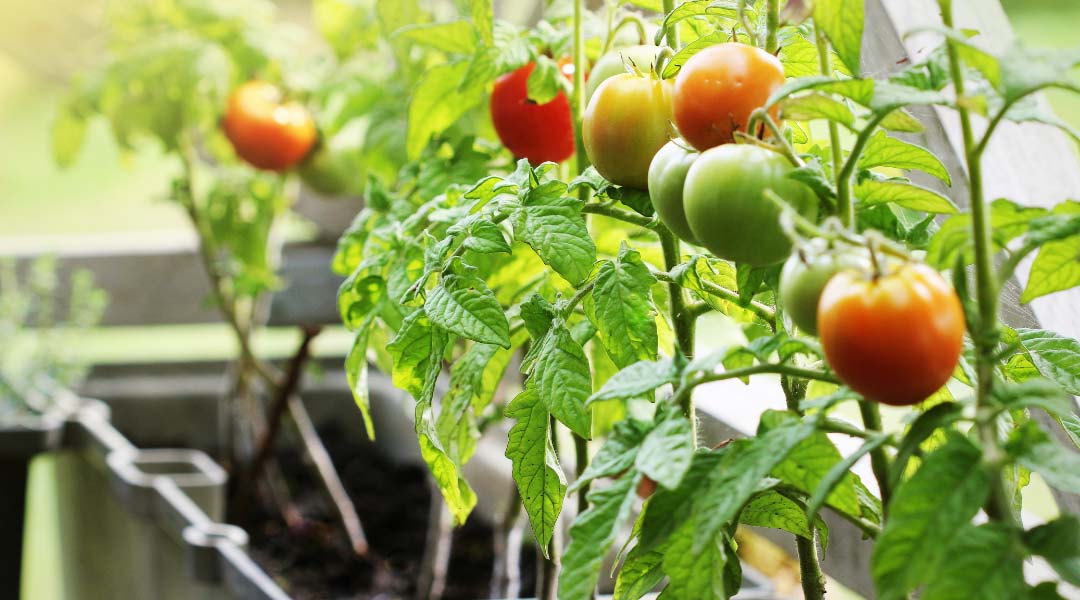Container vegetable gardening has become an increasingly popular method for urban dwellers, apartment residents, and anyone with limited outdoor space. Whether you have a small balcony, a sunny windowsill, or a tiny backyard, growing vegetables in containers allows you to enjoy fresh produce without needing a traditional garden. Among the myriad of vegetables that thrive in containers, tomatoes stand out for their versatility and the satisfaction of biting into a homegrown, sun-ripened fruit. In this guide, we’ll explore everything you need to know about growing tomatoes in containers, from selecting the right variety to harvesting the perfect tomato.
Tomatoes come in two main types: determinate and indeterminate. Determinate varieties, also known as bush tomatoes, grow to a certain height and produce fruit all at once. They are generally more compact, making them ideal for container gardening. Indeterminate varieties, or vining tomatoes, grow continuously throughout the season and can become quite large, which may require more space and support.
For container gardening, determinate varieties are often the best choice. Some popular options include:
- Patio Princess: A compact variety specifically bred for container gardening, producing small, flavorful fruits.
- Bush Early Girl: Known for its early harvest and abundant fruit, this variety is perfect for small spaces.
- Tumbler: Ideal for hanging baskets and small pots, Tumbler tomatoes cascade beautifully while producing a generous amount of cherry-sized fruits.
Selecting the right variety ensures that your tomato plant will thrive in the confined space of a container.
Selecting the Right Container
The container you choose is crucial for the health and productivity of your tomato plant. The size of the container directly impacts root development and the plant’s ability to access nutrients and water. For most tomato varieties, a container with a capacity of at least 5 gallons and a diameter of 10-12 inches is recommended. Larger varieties may require even bigger containers, such as a 10-gallon pot.
When it comes to material, options include plastic, terracotta, ceramic, and fabric pots. Plastic containers are lightweight, retain moisture well, and are generally more affordable. Terracotta pots, while attractive, can dry out quickly, so they require more frequent watering. Fabric pots, like Smart Pots, are a great option because they promote better aeration and root health.
Drainage is essential. Ensure that your container has sufficient drainage holes at the bottom to prevent waterlogging, which can lead to root rot. If your container doesn’t have holes, you can drill them yourself or add a layer of gravel at the bottom to help with drainage.
Preparing the Soil
Tomatoes thrive in rich, well-draining soil. The right soil mix is essential for providing your tomato plant with the nutrients it needs while preventing issues like compaction or poor drainage.
A high-quality potting mix is a great starting point. You can purchase a mix specifically designed for vegetables, or create your own by combining equal parts of:
- Peat Moss or Coconut Coir: To retain moisture and provide a light, airy texture.
- Compost or Well-Rotted Manure: To enrich the soil with essential nutrients.
- Perlite or Vermiculite: To improve drainage and prevent soil compaction.
Adding a slow-release organic fertilizer to the soil mix can give your tomato plants a head start. You can also mix in some garden lime if your soil tends to be acidic, as tomatoes prefer a slightly acidic to neutral pH (around 6.0-7.0).
Planting the Tomato
You have two options when starting your container tomato plant: growing from seeds or using transplants. Starting from seed allows you to choose from a wider variety of tomatoes, but it requires more time and care. If you’re new to gardening or prefer quicker results, transplants from a nursery are an excellent option.
When planting your tomato, bury the stem deeply—at least up to the first set of true leaves. Tomatoes can develop roots along the buried portion of the stem, which helps the plant establish a strong root system and improves stability. If you’re planting multiple tomatoes in one large container or planter box, make sure to space them at least 18-24 inches apart to prevent overcrowding.
Watering and Feeding
Consistent watering is key to growing healthy tomatoes in containers. Unlike garden tomatoes, container plants rely entirely on you for moisture, as they can’t draw water from deep in the ground.
- Watering Needs: Tomatoes need to be kept consistently moist, but not waterlogged. A general rule of thumb is to water when the top inch of soil feels dry. Water deeply until it drains out of the bottom of the container, ensuring that the entire root system is hydrated.
- Mulching: Adding a layer of mulch, such as straw or shredded leaves, on top of the soil can help retain moisture, reduce evaporation, and keep the soil temperature consistent.
- Fertilizing Schedule: Tomatoes are heavy feeders, especially when grown in containers. Start by mixing a balanced, slow-release fertilizer into the soil at planting time. As the plant grows and begins to set fruit, switch to a fertilizer higher in phosphorus and potassium, such as a tomato-specific fertilizer, to support flowering and fruit development. Feed your plants every 2-4 weeks during the growing season.
Supporting the Tomato Plant
Tomato plants, especially indeterminate varieties, need support to keep them upright and prevent the fruit from resting on the soil, where it can rot or be eaten by pests.
- Staking: Drive a sturdy stake into the soil near the plant and tie the main stem to it as the plant grows. This method is straightforward and works well for determinate varieties.
- Caging: Tomato cages are a popular option, providing support for the plant as it grows in all directions. Place the cage around the plant soon after planting to avoid damaging the roots.
- Trellising: For indeterminate varieties, a trellis system can be an effective way to train the plant upward, saving space and improving air circulation.
Whichever support method you choose, ensure that it is strong enough to handle the weight of a mature tomato plant laden with fruit.
Managing Pests and Diseases
Container gardening can reduce the risk of pests and diseases, but it’s not foolproof. Here are some common issues and how to handle them:
- Pests: Aphids, spider mites, and whiteflies are common pests that can affect container tomatoes. Regularly inspect your plants, and if you spot pests, treat them with organic insecticidal soap or neem oil. You can also introduce beneficial insects like ladybugs to your garden to help control pest populations.
- Diseases: Tomatoes are susceptible to diseases like blight, powdery mildew, and root rot. To prevent these, avoid overhead watering, provide good air circulation, and rotate your crops if possible. If you notice signs of disease, such as yellowing leaves or spots, remove affected leaves and treat the plant with an appropriate organic fungicide.
Harvesting
One of the most rewarding aspects of growing tomatoes in containers is the harvest. Knowing when to pick your tomatoes can make all the difference in flavor.
- When to Harvest: Tomatoes should be harvested when they are fully colored and slightly soft to the touch. Depending on the variety, this could be when they are bright red, yellow, or even purple. Avoid picking tomatoes when they are still green unless you’re growing a variety that is green when ripe.
- Harvesting Techniques: Use a sharp pair of scissors or garden pruners to cut the fruit from the vine, leaving a small portion of the stem attached. This helps prevent damage to the plant and encourages further fruit production.
Overcoming Common Challenges
Even with the best care, container tomatoes can face challenges. Here are solutions to some of the most common issues:
- Blossom End Rot: This condition causes dark, sunken spots on the bottom of the fruit and is often due to calcium deficiency or inconsistent watering. To prevent it, maintain even soil moisture and consider adding calcium to your soil mix at planting time.
- Cracking and Splitting: Tomatoes may crack if they receive an irregular supply of water, such as after a heavy rain following a dry spell. Prevent this by watering consistently and using mulch to help regulate soil moisture.
Tips for Maximizing Yield
To get the most out of your container tomato plants, consider these tips:
- Pruning and Pinching: Removing the small shoots, known as suckers, that grow between the main stem and branches can help direct the plant’s energy toward fruit production. However, be careful not to over-prune, as the leaves also help feed the plant through photosynthesis.
- Companion Planting: Growing certain plants alongside tomatoes can boost their growth and deter pests. Basil, for example, is said to improve the flavor of tomatoes and repel insects like aphids and whiteflies. Marigolds are also great companions, known for deterring nematodes and other pests.
Seasonal Care and Maintenance
Tomatoes are a warm-weather crop, but with the right care, you can extend your growing season.
- Adjusting Care for Weather Changes: In hot summer months, you may need to water your tomatoes more frequently and provide shade during the hottest part of the day to prevent sunscald. As the weather cools in the fall, consider using a cloche or moving containers to a warmer spot to extend the growing season.
- Overwintering Techniques: If you live in a mild climate, you may be able to keep your tomato plants alive through the winter by bringing containers indoors or into a greenhouse. Alternatively, you can start new plants from cuttings taken before the first frost.
Conclusion
Growing tomatoes in containers is a rewarding experience that allows you to enjoy fresh, homegrown tomatoes even if you have limited space. By choosing the right variety, container, and soil, and providing proper care throughout the growing season, you can achieve a bountiful harvest. Remember, the key to success is consistency in watering, feeding, and supporting your plants, along with a keen eye for potential problems. With a little effort and attention, you’ll be enjoying the taste of ripe, juicy tomatoes straight from your container garden in no time.
Additional Resources
- Further Reading:
- Guide to Container Gardening
- Organic Pest Control for Your Garden
- How to Make the Perfect Compost
- Recommended Tools and Supplies:
- Watering Can with Long Spout: Ideal for precise watering.
- Tomato Fertilizer: Organic options tailored for tomatoes.
- Garden Pruners: For harvesting and pruning plants.
- Mulch: Straw or wood chips to retain soil moisture.


0 Comments